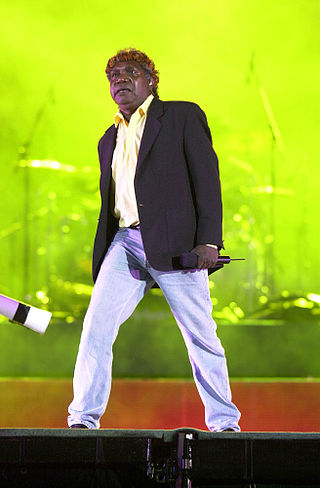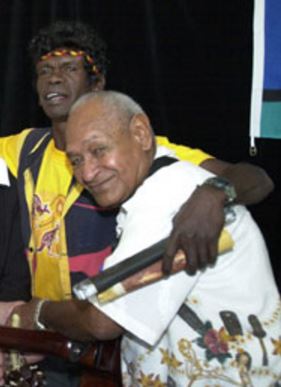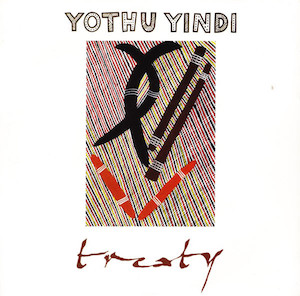Related Research Articles

Yothu Yindi are an Australian musical group with Aboriginal and non-Aboriginal members, formed in 1986 as a merger of two bands formed in 1985 – a white rock group called the Swamp Jockeys, and an unnamed Aboriginal folk group consisting of Mandawuy Yunupingu, Witiyana Marika, and Milkayngu Mununggur. The Aboriginal members came from Yolngu homelands near Yirrkala on the Gove Peninsula in Northern Territory's Arnhem Land. Founding members included Stuart Kellaway on bass guitar, Cal Williams on lead guitar, Andrew Belletty on drums, Witiyana Marika on manikay, bilma and dance, Milkayngu Mununggurr on yidaki, Geoffrey Gurrumul Yunupingu on keyboards, guitar, and percussion, past lead singer Mandawuy Yunupingu and present Yirrnga Yunupingu on vocals and guitar.

Mandawuy Djarrtjuntjun Yunupingu, formerly Tom Djambayang Bakamana Yunupingu, and also known as Dr Yunupingu, was a teacher and musician, and frontman of the Aboriginal rock group Yothu Yindi from 1986. He was an Aboriginal Australian man of the Yolŋu people, with a skin name of Gudjuk.

Arnhem Land is a historical region of the Northern Territory of Australia. It is located in the north-eastern corner of the territory and is around 500 km (310 mi) from the territorial capital, Darwin. In 1623, Dutch East India Company captain Willem Joosten van Colster sailed into the Gulf of Carpentaria and Cape Arnhem is named after his ship, the Arnhem, which itself was named after the city of Arnhem in the Netherlands.
Djalu Gurruwiwi, written Djalu, was a Yolngu musician, artist, and leader from Arnhem Land in the Northern Territory of Australia. He was globally recognised for his acquired skill as a player, maker, and spiritual keeper of the yiḏaki. As a respected artist with many of his works in several galleries, he aimed to spread his culture and traditions past his own community.

Galarrwuy Yunupingu, also known as James Galarrwuy Yunupingu and Dr Yunupingu, was an Indigenous Australian activist who was a leader in the Aboriginal Australian community. He was involved in Indigenous land rights throughout his career. He was a Yolngu man of the Gumatj clan, from Arnhem Land in the Northern Territory. He was the 1978 Australian of the Year.

The Yolngu or Yolŋu are an aggregation of Aboriginal Australian people inhabiting north-eastern Arnhem Land in the Northern Territory of Australia. Yolngu means "person" in the Yolŋu languages. The terms Murngin, Wulamba, Yalnumata, Murrgin and Yulangor were formerly used by some anthropologists for the Yolngu.
The Gove Peninsula is at the northeastern corner of Arnhem Land in the Northern Territory of Australia. The peninsula became strategically important during World War II when a Royal Australian Air Force base was constructed at what is now Gove Airport. The peninsula was involved in a famous court case known as the Gove land rights case, when local Yolngu people tried to claim native title over their traditional lands in 1971, after the Australian Government had granted a mineral lease to a bauxite mining company without consulting the local peoples. Today the land is owned by the Yolngu people.

Nhulunbuy is a town and locality in the Northern Territory of Australia. Founded on the Gove Peninsula in north-east Arnhem Land when a bauxite mine and deep water port were established in the late 1960s, the town's economy largely revolved around its alumina refinery until it closed in May 2014.

George Rrurrambu Burarrwanga, known in life as George Rrurrambu and George Djilangya, was known as the frontman of Warumpi Band, an Aboriginal rock band.

Yirrkala is a small community in East Arnhem Region, Northern Territory, Australia, 18 kilometres (11 mi) southeast of the large mining town of Nhulunbuy, on the Gove Peninsula in Arnhem Land.
The Yirrkala bark petitions, sent by the Yolngu people, an Aboriginal Australian people of Arnhem Land in the Northern Territory, to the Australian Parliament in 1963, were the first traditional documents prepared by Indigenous Australians that were recognised by the Australian Parliament, and the first documentary recognition of Indigenous people in Australian law. The petitions asserted that the Yolngu people owned land over which the federal government had granted mining rights to a private company, Nabalco.

Yolŋu Matha, meaning the 'Yolŋu tongue', is a linguistic family that includes the languages of the Yolngu, the indigenous people of northeast Arnhem Land in northern Australia. The ŋ in Yolŋu is pronounced as the ng in singing.
Australian Aboriginal culture includes a number of practices and ceremonies centered on a belief in the Dreamtime and other mythology. Reverence and respect for the land and oral traditions are emphasised. The words "law" and "lore", the latter relating to the customs and stories passed down through the generations, are commonly used interchangeably. Learned from childhood, lore dictates the rules on how to interact with the land, kinship and community.
Raymattja Marika, also known as Gunutjpitt Gunuwanga, was a Yolngu leader, scholar, educator, translator, linguist and cultural advocate for Aboriginal Australians. She was a Director of Reconciliation Australia and a member of the Australian Institute of Aboriginal and Torres Strait Islander Studies. She was also a director of the Yothu Yindi Foundation and a participant in the 2020 Summit, which was held in April 2008. Marika advocated understanding and reconciliation between Indigenous Australian and Western cultures.

"Treaty" is a protest song by Australian musical group Yothu Yindi, which is made up of Aboriginal and balanda (non-Aboriginal) members. Released in June 1991, "Treaty" was the first song by a predominantly Aboriginal band to chart in Australia and was the first song partly in any Aboriginal Australian language to gain extensive international recognition, peaking at No. 6 on the Billboard Hot Dance Club Play singles charts. The song contains lyrics in Gumatj, one of the Yolngu Matha dialects and a language of the Yolngu people of Arnhem Land in northern Australia.

Timmy Murmurrga Burarrwanga, also known by his tribal name Djawa Djuwait, is an Aboriginal Australian who belongs to the Gumatj clan. He is a business operator, cultural leader and current chairman of the Yirrkala Dhanbul Aboriginal Corporation, a community development organization associated with the Bunuwal group of companies. He was formerly a director of the Lanyhapuy Homelands Association, and is heavily active in the outstation movement, numerous other Aboriginal organizations, and has lent his support to the One Laptop Per Child Australia group.
The Garrangali Band, also known as Garrangali, is an Aboriginal Australian musical group from the tiny homeland community, or outstation, of Baniyala in East Arnhem Land in the Northern Territory of Australia. Garrangali means "home of the crocodile" in the Yolngu language, in which they sing some lyrics. Their musical style has been variously described as reggae, saltwater reggae and saltwater ska.

Wukun Wanambi was an Australian Yolngu painter, filmmaker and curator of the Marrakulu clan of northeastern Arnhem Land, Northern Territory.
Banula (David) Marika is an Aboriginal Australian dancer, actor, singer and performer from Yirrkala in North East Arnhem Land, in the Northern Territory of Australia. The son of Roy Marika, he is a member of the Rirratjingu clan of the Yolngu people, and is known for his performances with the Bangarra Dance Theatre since the 1990s.
The Arnhem Space Centre (ASC) is Australia's first and only commercial spaceport, located near Nhulunbuy, in Arnhem Land, Australia. It is owned and operated by Equatorial Launch Australia (ELA), and it is the site of NASA's first non-orbital sounding rocket launch from a commercial port outside the United States on 27 June 2022.
References
- ↑ "Garma 2018 Report". Archived from the original on 1 December 2020. Retrieved 1 May 2019.
- 1 2 "Gumatj Corporation". Austrade. 31 October 2017. Retrieved 6 October 2020.
- ↑ Vivian, Steve (31 May 2021). "Garma festival cancelled over COVID fears in 'big blow' to local communities". ABC News. Australian Broadcasting Corporation. Retrieved 3 July 2021.
- 1 2 3 Morse, Dana (4 August 2024). "Three years, three Garma festivals, and three different versions of Anthony Albanese". ABC News. Retrieved 9 August 2024.
- ↑ Karvelas, Patricia (4 August 2023). "Anthony Albanese promises to hold Voice referendum in 2023 in keynote Garma Festival speech". ABC News. Retrieved 9 August 2024.
- ↑ IN FULL: Prime Minister Anthony Albanese gives speech at the Garma Festival 2023 on YouTube. ABC News
- ↑ Latimore, Jack (2 August 2023). "Garma Festival 2023: Everything you need to know". The Sydney Morning Herald . Retrieved 9 August 2024.
- ↑ "Address to the Garma Festival". Prime Minister of Australia . 3 August 2024. Retrieved 9 August 2024.
- 1 2 "Garma Festival has begun for 2024". The Daily Aus . 2 August 2024. Retrieved 9 August 2024.
- ↑ Bowers, Mike (7 August 2024). "'After the Fire': Gumatj leader Djawa Yunupingu looks to the future – Garma 2024 in pictures". the Guardian. Retrieved 9 August 2024.
- ↑ "garma(')". Yolŋu Matha Dictionary. Charles Darwin University. Retrieved 9 August 2024.
- ↑ Lowe, Beulah (2014). Yolŋu–English Dictionary (PDF). Aboriginal Resource and Development Services. p. 81.
- ↑ "Nhulunbuy on the Gove Peninsula, East Arnhem Land, NT". Gove Online. 28 December 2016. Archived from the original on 8 August 2022. Retrieved 6 October 2020.
- ↑ Brancatisano, Emma (3 August 2023). "What is the Garma Festival and why is it significant?". SBS News. Retrieved 9 August 2024.
- ↑ Allam, Lorena (5 August 2023). "Garma festival: Yunupingu's legacy, the Indigenous voice and the fight for 'a world that is better than the past'". The Guardian. Retrieved 9 August 2024.
- ↑ "Garma Festival of Traditional Cultures". Garma Festival of Traditional Cultures. Retrieved 1 May 2019.
- ↑ Grabowsky, Paul (1 October 2014). "The best of Australian arts 2014: Concert music". The Monthly. Retrieved 22 January 2020.
- ↑ McAllister, Jai; Moran, Alexis (2 August 2019). "Why is the Garma Festival important?". ABC News. Australian Broadcasting Corporation. Retrieved 29 January 2020.
- ↑ Davidson, Helen (5 August 2019). "'A little bit of heat': how Garma festival became the main event for Indigenous affairs". The Guardian. ISSN 0261-3077 . Retrieved 23 January 2020.
- ↑ "Garma Festival spotlights decline in NT bilingual teachers". ABC Radio. 3 August 2019. Retrieved 23 January 2020.
- ↑ Davidson, Helen (4 August 2019). "Australia to be sued over mining project's 'unmerciful' destruction of Indigenous land". The Guardian. ISSN 0261-3077 . Retrieved 23 January 2020.
- ↑ "Constitutional recognition dominates Garma agenda". ABC Radio. 5 August 2019. Retrieved 23 January 2020.
- ↑ Davidson, Helen (3 August 2019). "Yothu Yindi Foundation chief says Australian governments 'dining out' on Aboriginal misery". The Guardian. ISSN 0261-3077 . Retrieved 23 January 2020.
- ↑ "The Imagination Declaration of the Youth Forum read at Garma 2019". NITV. Retrieved 23 January 2020.
- ↑ "Djalu Gurruwiwi". iDIDJ Australia. Retrieved 20 January 2020.
- ↑ "Everything you need to know about The Garma Festival in Arnhem Land". Australian Traveller. 19 July 2018. Retrieved 20 January 2020.
- 1 2 Garrick, Matt (12 September 2020). "Northern Territory historical society saves satellite tracker from scrap heap after a 3,000 km journey". ABC News. Australian Broadcasting Corporation. Retrieved 6 October 2020.
- ↑ "Garma Program Booklet 2018" (PDF).
- 1 2 Garrick, Matt (31 July 2019). "NASA scientists visit NT site which could eventually blast rockets to the Moon". ABC News. Australian Broadcasting Corporation. Retrieved 6 October 2020.
- ↑ Gibson, Jano (31 May 2019). "NASA to launch rockets into space from Northern Territory spaceport". ABC News. Australian Broadcasting Corporation. Retrieved 6 October 2020.
- ↑ Braue, David (4 June 2019). "NASA to launch rockets from Northern Territory". Information Age. Retrieved 6 October 2020.